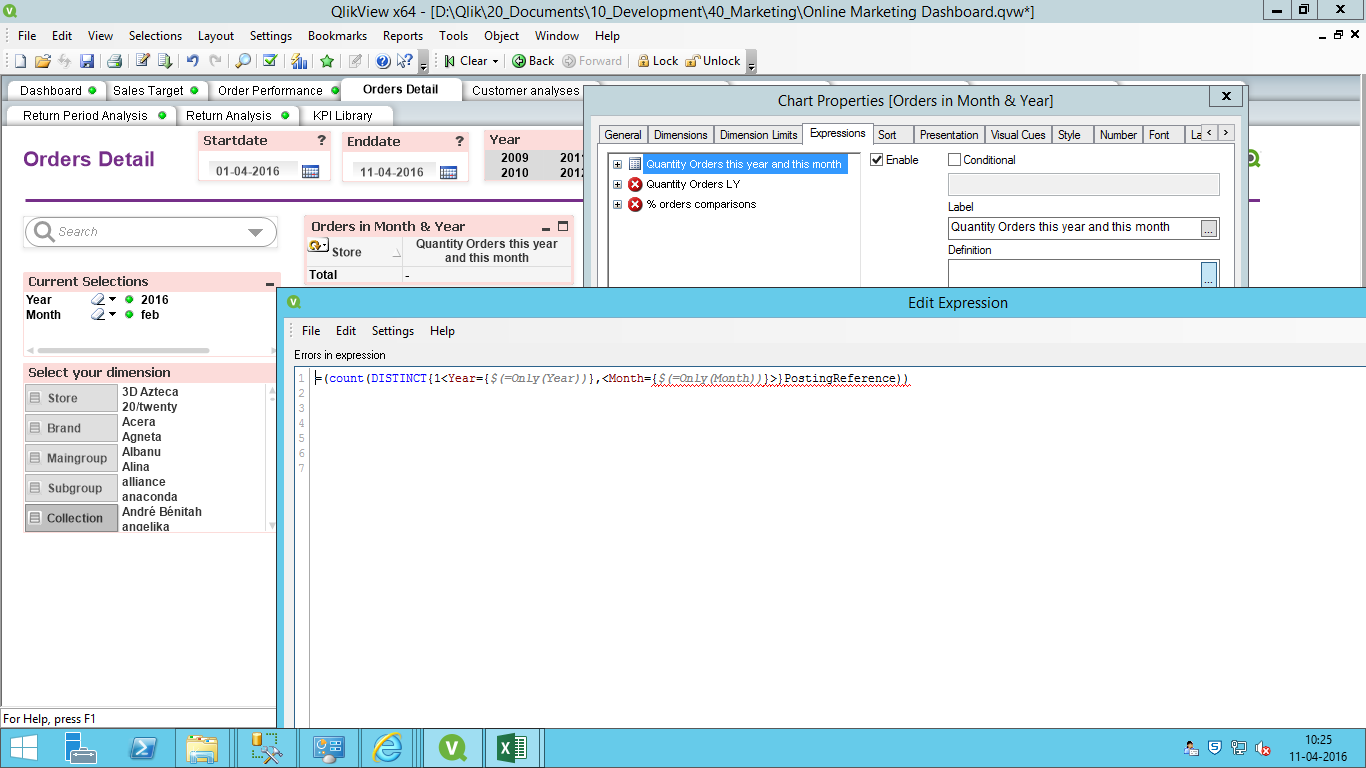Unlock a world of possibilities! Login now and discover the exclusive benefits awaiting you.
- Qlik Community
- :
- All Forums
- :
- QlikView App Dev
- :
- Set analysis with two period variables
- Subscribe to RSS Feed
- Mark Topic as New
- Mark Topic as Read
- Float this Topic for Current User
- Bookmark
- Subscribe
- Mute
- Printer Friendly Page
- Mark as New
- Bookmark
- Subscribe
- Mute
- Subscribe to RSS Feed
- Permalink
- Report Inappropriate Content
Set analysis with two period variables
Goodmorning all,
I want to create weborders (PostingReference) with '1' operator for Total orders based on Year and Month.
unfortunatly, the following set analysis expression doesn't work:
=(count(DISTINCT{1<Year={$(=Only(Year))},<Month={$(=Only(Month))}>}PostingReference))
What did i wrong?
Thanks regards,
Rega

Accepted Solutions
- Mark as New
- Bookmark
- Subscribe
- Mute
- Subscribe to RSS Feed
- Permalink
- Report Inappropriate Content
remove "<" this
=(count(DISTINCT{1<Year={$(=Only(Year))},Month={$(=Only(Month))}>}PostingReference))
- Mark as New
- Bookmark
- Subscribe
- Mute
- Subscribe to RSS Feed
- Permalink
- Report Inappropriate Content
Hi Rega,
I can see one extra angle bracket in your set analysis.
=(count(DISTINCT{1<Year={$(=Only(Year))}, < Month={$(=Only(Month))}>}PostingReference))
Reomve the angle bracket and try,
=count(DISTINCT{1<Year={$(=Only(Year))},Month={$(=Only(Month))}>}PostingReference)
- Mark as New
- Bookmark
- Subscribe
- Mute
- Subscribe to RSS Feed
- Permalink
- Report Inappropriate Content
remove "<" this
=(count(DISTINCT{1<Year={$(=Only(Year))},Month={$(=Only(Month))}>}PostingReference))
- Mark as New
- Bookmark
- Subscribe
- Mute
- Subscribe to RSS Feed
- Permalink
- Report Inappropriate Content
try this
(count(DISTINCT{1<Year={"$(=max(Year))"},Month={"$(=max(Month))"}>}PostingReference))
- Mark as New
- Bookmark
- Subscribe
- Mute
- Subscribe to RSS Feed
- Permalink
- Report Inappropriate Content
Hi Rega Sanyoto,
Try this:
=(count(DISTINCT{1<Year={"$(=Only(Year))"}, Month={"$(=Only(Month))"}>}PostingReference))
Regards,
Anjali Gupta
- Mark as New
- Bookmark
- Subscribe
- Mute
- Subscribe to RSS Feed
- Permalink
- Report Inappropriate Content
As set analysis is calculated globally, the Only() function for year and month will return null() -- unless there is only on possible value for year and month in the entire data model. You may be able to use Max() instead. You need to quote the search expressions as well:
=count(DISTINCT {1<Year={"$(=Max(Year))"},<Month={"$(=Max(Month))"}>} PostingReference)
Do you want to ignore all selections? If you wish to override only the year and month values, then drop the "1":
=count(DISTINCT {<Year={"$(=Max(Year))"},<Month={"$(=Max(Month))"}>} PostingReference)